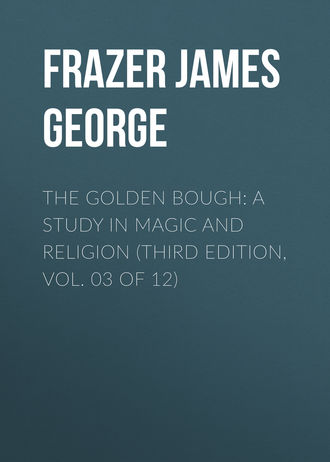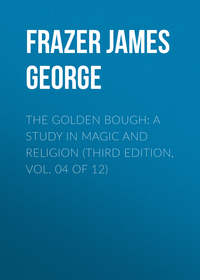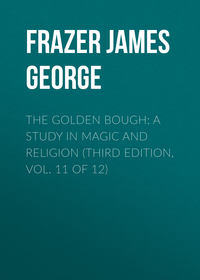 полная версия
полная версияThe Golden Bough: A Study in Magic and Religion (Third Edition, Vol. 03 of 12)
473
R. H. Codrington, The Melanesians, pp. 203 sq., compare pp. 178, 188, 214.
474
G. Turner, Samoa, pp. 302 sq. See The Magic Art and the Evolution of Kings, i. 341 sq.
475
K. Vetter, Komm herüber und hilf uns! iii. (Barmen, 1898) p. 9; M. Krieger, Neu-Guinea, pp. 185 sq.; R. Parkinson, “Die Berlinhafen Section, ein Beitrag zur Ethnographie der Neu-Guinea Küste,” Internationales Archiv für Ethnographie, xiii. (1900) p. 44; M. J. Erdweg, “Die Bewohner der Insel Tumleo, Berlinhafen, Deutsch-Neu-Guinea,” Mittheilungen der Anthropologischen Gesellschaft in Wien, xxxii. (1902) p. 287.
476
Mgr. Couppé, “En Nouvelle-Poméranie,” Missions Catholiques, xxiii. (1891) p. 364; J. Graf Pfeil, Studien und Beobachtungen aus der Südsee (Brunswick, 1899), pp. 141 sq.; P. A. Kleintitschen, Die Küstenbewohner der Gazellehalbinsel (Hiltrup bei Münster, n. d.), pp. 343 sq.
477
O. Dapper, Description de l'Afrique, p. 330. We have seen that the food left by the king of the Monbutto, is carefully buried (above, p. 119).
478
Bosman's “Guinea,” in Pinkerton's Voyages and Travels, xvi. 487.
479
P. N. Wilken, “Bijdragen tot de kennis van de zeden en gewoonten der Alfoeren in de Minahassa,” Mededeelingen van wege het Nederlandsche Zendelinggenootschap, vii. (1863) p. 126.
480
W. Caland, Altindisches Zauberritual, pp. 163 sq.
481
Pliny, Nat. Hist. xxviii. 19. For other examples of witchcraft wrought by means of the refuse of food, see E. S. Hartland, The Legend of Perseus, ii. 83 sqq.
482
On the covenant entered into by eating together see the classical exposition of W. Robertson Smith, The Religion of the Semites2 (London, 1894), pp. 269 sqq. For examples of the blood-covenant, see H. C. Trumbull, The Blood Covenant (London, 1887). The examples might easily be multiplied.
483
Kaempfer's “History of Japan,” in Pinkerton's Voyages and Travels, vii. 717.
484
Rev. Lorimer Fison, in a letter to me dated August 26, 1898. In Fijian, kana is to eat; the meaning of lama is unknown.
485
“Coutumes étranges des indigènes du Djebel-Nouba,” Missions Catholiques, xiv. (1882) p. 460; Father S. Carceri, “Djebel-Nouba,” ibid. xv. (1883) p. 450. The title of the priestly king is cogiour or codjour. “The codjour is the pontifical king of each group of villages; it is he who regulates and administers the affairs of the Nubas. He is an absolute monarch, on whom all depend. But he has no princely privileges or immunities; no royal insignia, no badge mark him off from his subjects. He lives like them by the produce of his fields and his industry; he works like them, earns his daily bread, and has no guard of honour, no tribunal, no code of laws, no civil list” (Father S. Carceri, loc. cit.).
486
“Der Muata Cazembe und die Völkerstämme der Maravis, Chevas, Muembas, Lundas und andere von Süd-Afrika,” Zeitschrift für allgemeine Erdkunde (Berlin), vi. (1856) pp. 398 sq.; F. T. Valdez, Six Years of a Traveller's Life in Western Africa (London, 1861), ii. 251 sq.
487
W. Mariner, The Natives of the Tonga Islands,2 i. 141 sq. note, 434 note, ii. 82 sq., 221-224; Captain J. Cook, Voyages (London, 1809), v. 427 sq. Similarly in Fiji any person who had touched the head of a living chief or the body of a dead one was forbidden to handle his food, and must be fed by another (J. E. Erskine, The Western Pacific, p. 254).
488
On the custom of touching for the King's Evil, see The Magic Art and the Evolution of Kings, vol. i. pp. 368 sqq.
489
“The idea in which this law [the law of taboo or tapu, as it was called in New Zealand] originated appears to have been, that a portion of the spiritual essence of an atua or of a sacred person was communicated directly to objects which they touched, and also that the spiritual essence so communicated to any object was afterwards more or less retransmitted to anything else brought into contact with it” (E. Shortland, Traditions and Superstitions of the New Zealanders, Second Edition, London, 1856, p. 102). Compare id., Maori Religion and Mythology, p. 25.
490
Old New Zealand, by a Pakeha Maori (London, 1884), pp. 96 sq.
491
W. Brown, New Zealand and its Aborigines (London, 1845), p. 76. For more examples of the same kind see ibid. pp. 177 sq.
492
E. Tregear, “The Maoris of New Zealand,” Journal of the Anthropological Institute, xix. (1890) p. 100.
493
R. Taylor, Te Ika a Maui, or, New Zealand and its Inhabitants,2 p. 164.
494
R. Taylor, op. cit. p. 165.
495
Spencer and Gillen, Native Tribes of Central Australia, pp. 537 sq.
496
R. Southey, History of Brazil, i.2 (London, 1822), p. 238.
497
Major A. G. Leonard, The Lower Niger and its Tribes (London, 1906), pp. 257 sq.
498
Merolla's “Voyage to Congo,” in Pinkerton's Voyages and Travels, xvi. 237 sq. As to these chegilla or taboos on food, which are commonly observed by the natives of this part of Africa, see further my Totemism and Exogamy, ii. 614 sqq.
499
W. Ellis, Polynesian Researches (Second Edition, London, 1832-1836), iv. 388. Ellis appears to imply that the rule was universal in Polynesia, but perhaps he refers only to Hawaii, of which in this part of his work he is specially treating. We are told that in Hawaii the priest who carried the principal idol about the country was tabooed during the performance of this sacred office; he might not touch anything with his hands, and the morsels of food which he ate had to be put into his mouth by the chiefs of the villages through which he passed or even by the king himself, who accompanied the priest on his rounds (L. de Freycinet, Voyage autour du monde, Historique, ii. Première Partie, Paris, 1829, p. 596). In Tonga the rule applied to chiefs only when their hands had become tabooed by touching a superior chief (W. Mariner, Tonga Islands, i. 82 sq.). In New Zealand chiefs were fed by slaves (A. S. Thomson, The Story of New Zealand, i. 102); or they may, like tabooed people in general, have taken up their food from little stages with their mouths or by means of fern-stalks (R. Taylor, Te Ika a Maui, or New Zealand and its Inhabitants,2 p. 162).
500
Old New Zealand, by a Pakeha Maori (London, 1884), pp. 104-114. For more evidence see W. Yate, New Zealand, p. 85; G. F. Angas, Savage Life and Scenes in Australia and New Zealand, ii. 90; E. Dieffenbach, Travels in New Zealand, ii. 104 sq.; J. Dumont D'Urville, Voyage autour du monde et à la recherche de La Pérouse, ii. 530; Father Servant, “Notice sur la Nouvelle Zélande,” Annales de la Propagation de la Foi, xv. (1843) p. 22.
501
G. Turner, Samoa, p. 145. Compare G. Brown, D.D., Melanesians and Polynesians (London, 1910), p. 402: “The men who took hold of the body were paia (sacred) for the time, were forbidden to touch their own food, and were fed by others. No food wad eaten in the same house with the dead body.”
502
W. Mariner, The Natives of the Tonga Islands2 (London, 1818), i. 141 sq., note.
503
Father Bataillon, in Annales de la Propagation de la Foi, xiii. (1841) p. 19. For more evidence of the practice of this custom in Polynesia, see Captain J. Cook, Voyages (London, 1809), vii. 147; James Wilson, Missionary Voyage to the Southern Pacific Ocean (London, 1799), p. 363.
504
Ch. Wilkes, Narrative of the United States Exploring Expedition, New Edition (New York, 1851), iii. 99 sq.
505
W. G. Lawes, “Ethnological Notes on the Motu, Koitapu, and Koiari Tribes of New Guinea,” Journal of the Anthropological Institute, viii. (1879) p. 370.
506
Father Lambert, in Missions Catholiques, xii. (1880) p. 365; id., Mœurs et superstitions des Néo-Calédoniens (Nouméa, 1900), pp. 238 sq.
507
A. C. Hollis, The Nandi (Oxford, 1909), p. 70.
508
H. A. Junod, “Les Conceptions physiologiques des Bantou sud-africains et leurs tabous,” Revue d'Ethnographie et de Sociologie, i. (1910) p. 153.
509
A. W. Howitt, Native Tribes of South-East Australia, p. 563.
510
Fr. Boas, in Sixth Report on the North-Western Tribes of Canada, pp. 91 sq. (separate Reprint from the Report of the British Association for 1890).
511
J. Teit, “The Thompson Indians of British Columbia,” Memoir of the American Museum of Natural History, The Jesup North Pacific Expedition, vol. i. part iv. (April 1900) pp. 331, 332 sq.
512
C. Hill-Tout, The Far West, the Home of the Salish and Déné (London, 1907), pp. 193 sq.
513
G. M. Dawson, “Notes and Observations on the Kwakiool People of the Northern part of Vancouver Island and adjacent Coasts,” Proceedings and Transactions of the Royal Society of Canada for the Year 1887, vol. v. (Montreal, 1888) Trans. Section ii. pp. 78 sq.
514
F. Blumentritt, “Über die Eingeborenen der Insel Palawan und der Inselgruppe der Talamlanen,” Globus, lix. (1891) p. 182.
515
Father Guis, “Les Canaques, Mort-Deuil,” Missions Catholiques, xxxiv. (1902) pp. 208 sq.
516
Capt. W. E. Armit, “Customs of the Australian Aborigines,” Journal of the Anthropological Institute, ix. (1880) p. 459.
517
W. Ridley, “Report on Australian Languages and Traditions,” Journal of the Anthropological Institute, ii. (1873) p. 268.
518
From information given me by Messrs. Roscoe and Miller, missionaries to Uganda (June 24, 1897), and afterwards corrected by the Katikiro (Prime Minister) of Uganda in conversation with Mr. Roscoe (June 20, 1902).
519
Report of the International Polar Expedition to Point Barrow, Alaska (Washington, 1885), p. 46.
520
Alexander Mackenzie, Voyages from Montreal through the Continent of North America (London, 1801), p. cxxiii.
521
Gavin Hamilton, “Customs of the New Caledonian Women,” Journal of the Anthropological Institute, vii. (1878) p. 206. Among the Nootkas of British Columbia a girl at puberty is hidden from the sight of men for several days behind a partition of mats; during her seclusion she may not scratch her head or her body with her hands, but she may do so with a comb or a piece of bone, which is provided for the purpose. See Fr. Boas, in Sixth Report on the North-Western Tribes of Canada, p. 41 (separate reprint from the Report of the British Association for 1890). Again, among the Shuswap of British Columbia a girl at puberty lives alone in a little hut on the mountains and is forbidden to touch her head or scratch her body; but she may scratch her head with a three-toothed comb and her body with the painted bone of a deer. See Fr. Boas, op. cit. pp. 89 sq. In the East Indian island of Ceram a girl may not scratch herself with her fingers the night before her teeth are filed, but she may do it with a piece of bamboo. See J. G. F. Riedel, De sluik- en kroesharige rassen tusschen Selebes en Papua, p. 137.
522
A. G. Morice, “The Canadian Dénés,” Annual Archaeological Report (Toronto), 1905, p. 218.
523
H. Pittier de Fabrega, “Die Sprache der Bribri-Indianer in Costa Rica,” Sitzungsberichte der philosophischen-historischen Classe der Kaiserlichen Akademie der Wissenschaften (Vienna), cxxxviii. (1898) p. 20.
524
C. G. Seligmann, in Reports of the Cambridge Anthropological Expedition to Torres Straits, v. (Cambridge, 1904) pp. 201, 203.
525
James Wilson, Missionary Voyage to the Southern Pacific Ocean, p. 354.
526
G. Turner, Samoa, p. 276.
527
C. G. Seligmann, “The Medicine, Surgery, and Midwifery of the Sinaugolo,” Journal of the Anthropological Institute, xxxii. (1902) p. 302. In Uganda a bride is secluded for a month, during which she only receives near relatives; she wears her veil all this time. She may not handle food, but is fed by one of her attendants. A peasant's wife is secluded for two or three days only. See J. Roscoe, “Further Notes on the Manners and Customs of the Baganda,” Journal of the Anthropological Institute, xxxii. (1902) p. 37.
528
Father Guis, “Les Canaques, ce qu'ils font, ce qu'ils disent,” Missions Catholiques, xxx. (1898) p. 119.
529
V. Lisiansky, A Voyage Round the World (London, 1814), p. 201.
530
H. A. Junod, “Les Conceptions physiologiques des Bantou sud-africains et leurs tabous,” Revue d' Ethnographie et de Sociologie, i. (1910) p. 153.
531
H. Pittier de Fábrega, op. cit. pp. 20 sq.
532
F. Fawcett, “Note on a Custom of the Mysore ‘Gollaválu’ or Shepherd Caste People,” Journal of the Anthropological Society of Bombay, i. 536 sq.; E. Thurston, Castes and Tribes of Southern India (Madras, 1909), ii. 287 sq.
533
M. J. Erdweg, “Die Bewohner der Insel Tumleo, Berlinhafen, Deutsch Neu-Guinea,” Mittheilungen der Anthropologischen Gesellschaft in Wien, xxxii. (1902) p. 280.
534
P. Rascher, “Die Sulka,” Archiv für Anthropologie, xxix. (1904) p. 212; R. Parkinson, Dreissig Jahre in der Südsee (Stuttgart, 1907), p. 180.
535
K. Vetter, in Nachrichten über Kaiser Wilhelms-Land und den Bismarck-Archipel, 1897, p. 87.
536
Rev. E. Dannert, “Customs of the Ovaherero at the Birth of a Child,” (South African) Folk-lore Journal, ii. (1880) p. 63.
537
Levrault, “Rapport sur les provinces de Canélos et du Napo,” Bulletin de la Société de Géographie (Paris), Deuxième Série, xi. (1839) p. 74.
538
Franz Boas, “The Eskimo of Baffin Land and Hudson Bay,” Bulletin of the American Museum of Natural History, xv. part i. (New York, 1901) pp. 125 sq. As to Sedna, see id. pp. 119 sqq.
539
H. A. Junod, “Les Conceptions physiologiques des Bantou sud-africains et leurs tabous,” Revue d'Ethnographie et de Sociologie, i. (1910) p. 139.
540
H. A. Junod, op. cit. pp. 139 sq.
541
H. A. Junod, op. cit. pp. 140 sq.
542
See The Magic Art and the Evolution of Kings, vol. i. pp. 262 sqq., 278.
543
Le R. P. Cadière, “Coutumes populaires de la vallée du Nguôn-So'n,” Bulletin de l'École Française d'Extrême-Orient, ii. (Hanoi, 1902) pp. 353 sq.
544
Dittenberger, Sylloge inscriptionum Graecarum,2 No. 566; Ch. Michel, Recueil d'inscriptions grecques, No. 730 ἁγνευέτωσαν δὲ καὶ εἰσίτωσαν εἰς τὸν τῆς θεο[ῦ ναὸν] … ὡσαύτως δὲ καὶ ἀπὸ κήδους καὶ τεκούσης γυναικὸς δευτεραῖος: Euripides, Iphigenia in Tauris, 380 sqq.:
τὰ τῆς θεοῦ δὲ μέμφομαι σοφίσματα, ἤτις. βροτῶν μὲν ἤν τις ἄψηται φόνου ἥ καὶ λοχείας ἢ νεκροῦ θιγῇ χεροῖν, βωμῶν ἀπείργει, μυσαρὸν ὡς ἡγουμένη.
Compare also a mutilated Greek inscription found in Egypt (Revue archéologique, IIIme Série, ii. 182 sqq.). In the passage of Euripides which I have just quoted an acute verbal scholar, the late Dr. Badham, proposed to omit the line ἢ καὶ λοχείας ἢ νεκροῦ θιγῇ χεροῖν with the comment: “Nihil facit ad argumentum puerperae mentio; patet versum a sciolo additum.” To do Dr. Badham justice, the inscription which furnishes so close a parallel to the line of Euripides had not yet been discovered among the ruins of Pergamum, when he proposed to mutilate the text of the poet.
545
B. Hawkins, “The Creek Confederacy,” Collections of the Georgia Historical Society, iii. pt. i. (Savannah, 1848) pp. 78 sq. Hawkins's account is reproduced by A. S. Gatschett, in his Migration Legend of the Creek Indians, i. 185 sq. (Philadelphia, 1884). In the Turrbal tribe of southern Queensland boys at initiation were not allowed to scratch themselves with their fingers, but they might do it with a stick. See A. W. Howitt, Native Tribes of South-East Australia, p. 596.
546
L. Alberti, De Kaffers (Amsterdam, 1810), pp. 76 sq.; H. Lichtenstein, Reisen im südlichen Afrika (Berlin, 1811-12), i. 427; S. Kay, Travels and Researches in Caffraria (London, 1833), pp. 273 sq.; Dudley Kidd, The Essential Kafir, p. 208; J. Stewart, D.D., Lovedale, South Africa (Edinburgh, 1894), pp. 105 sq., with illustrations.
547
Old New Zealand, by a Pakeha Maori (London, 1884), pp. 96, 114 sq. One of the customs mentioned by the writer was that all the people left in the camp had to fast strictly while the warriors were out in the field. This rule is obviously based on the sympathetic connexion supposed to exist between friends at a distance, especially at critical times. See The Magic Art and the Evolution of Kings, vol. i. pp. 126 sqq.
548
Deuteronomy xxiii. 9-14; 1 Samuel xxi. 5. The rule laid down in Deuteronomy xxiii. 10, 11, suffices to prove that the custom of continence observed in time of war by the Israelites, as by a multitude of savage and barbarous peoples, was based on a superstitious, not a rational motive. To convince us of this it is enough to remark that the rule is often observed by warriors for some time after their victorious return, and also by the persons left at home during the absence of the fighting men. In these cases the observance of the rule evidently does not admit of a rational explanation, which could hardly, indeed, be entertained by any one conversant with savage modes of thought. For examples, see The Magic Art and the Evolution of Kings, vol. i. pp. 125, 128, 131, 133, and below, pp. 161, 163, 165, 166, 167, 168, 169, 175 sq., 178, 179, 181.
The other rule of personal cleanliness referred to in the text is exactly observed, for the reason I have indicated, by the aborigines in various parts of Australia. See (Sir) George Grey, Journals, ii. 344; R. Brough Smyth, Aborigines of Victoria, i. 165; J. Dawson, Australian Aborigines, p. 12; P. Beveridge, in Journal and Proceedings of the Royal Society of New South Wales, xvii. (1883) pp. 69 sq. Compare W. Stanbridge, “On the Aborigines of Victoria,” Transactions of the Ethnological Society of London, N.S. i. (1861) p. 299; Fison and Howitt, Kamilaroi and Kurnai, p. 251; E. M. Curr, The Australian Race, iii. 178 sq., 547; W. E. Roth, North Queensland Ethnography, Bulletin No. 5 (Brisbane, 1903), p. 22, § 80. The same dread has resulted in a similar custom of cleanliness in Melanesia and Africa. See R. Parkinson, Im Bismarck-Archipel, pp. 143 sq.; R. H. Codrington, The Melanesians, p. 203 note; F. von Luschan, “Einiges über Sitten und Gebräuche der Eingeborenen Neu-Guineas,” Verhandlungen der Berliner Gesellschaft für Anthropologie, Ethnologie, und Urgeschichte (1900), p. 416; J. Macdonald, “Manners, Customs, Superstitions, and Religions of South African Tribes,” Journal of the Anthropological Institute, xx. (1891) p. 131. Mr. Lorimer Fison sent me some notes on the Fijian practice, which agrees with the one described by Dr. Codrington. The same rule is observed, probably from the same motives, by the Miranha Indians of Brazil. See Spix und Martius, Reise in Brasilien, iii. 1251 note. On this subject compare F. Schwally, Semitische Kriegsaltertümer, i. (Leipsic, 1901) pp. 67 sq.
549
Narrative of the Captivity and Adventures of John Tanner (London, 1830), p. 122.
550
We have seen (pp. 146, 156) that the same rule is observed by girls at puberty among some Indian tribes of British Columbia and by Creek lads at initiation. It is also observed by Kwakiutl Indians who have eaten human flesh (see below, p. 189). Among the Blackfoot Indians the man who was appointed every four years to take charge of the sacred pipe and other emblems of their religion might not scratch his body with his finger-nails, but carried a sharp stick in his hair which he used for this purpose. During the term of his priesthood he had to fast and practise strict continence. None but he dare handle the sacred pipe and emblems (W. W. Warren, “History of the Ojibways,” Collections of the Minnesota Historical Society, v. (1885) pp. 68 sq.). In Vedic India the man who was about to offer the solemn sacrifice of soma prepared himself for his duties by a ceremony of consecration, during which he carried the horn of a black deer or antelope wherewith to scratch himself if necessary (Satapatha-Brâhmana, bk. iii. 31, vol. ii. pp. 33 sq. trans. by J. Eggeling; H. Oldenberg, Die Religion des Veda, p. 399). Some of the Peruvian Indians used to prepare themselves for an important office by fasting, continence, and refusing to wash themselves, to comb their hair, and to put their hands to their heads; if they wished to scratch themselves, they must do it with a stick. See P. J. de Arriaga, Extirpacion de la idolatria del Piru (Lima, 1621), p. 20. Among the Isistines Indians of Paraguay mourners refrained from scratching their heads with their fingers, believing that to break the rule would make them bald, no hair growing on the part of the head which their fingers had touched. See Guevara, “Historia del Paraguay,” in P. de Angelis's Coleccion de obras y documentos relativos a la historia antigua y moderna de las provincias del Rio de la Plata, ii. (Buenos-Aires, 1836) p. 30. Amongst the Macusis of British Guiana, when a woman has given birth to a child, the father hangs up his hammock beside that of his wife and stays there till the navel-string drops off the child. During this time the parents have to observe certain rules, of which one is that they may not scratch their heads or bodies with their nails, but must use for this purpose a piece of palm-leaf. If they broke this rule, they think the child would die or be an invalid all its life. See R. Schomburgk, Reisen in Britisch-Guiana, ii. 314. Some aborigines of Queensland believe that if they scratched themselves with their fingers during a rain-making ceremony, no rain would fall. See The Magic Art and the Evolution of Kings, vol. i. p. 254. In all these cases, plainly, the hands are conceived to be so strongly infected with the venom of taboo that it is dangerous even for the owner of the hands to touch himself with them. The cowboy who herded the cows of the king of Unyoro had to live strictly chaste, no one might touch him, and he might not scratch or wound himself so as to draw blood. But it is not said that he was forbidden to touch himself with his own hands. See my Totemism and Exogamy, ii. 527.










